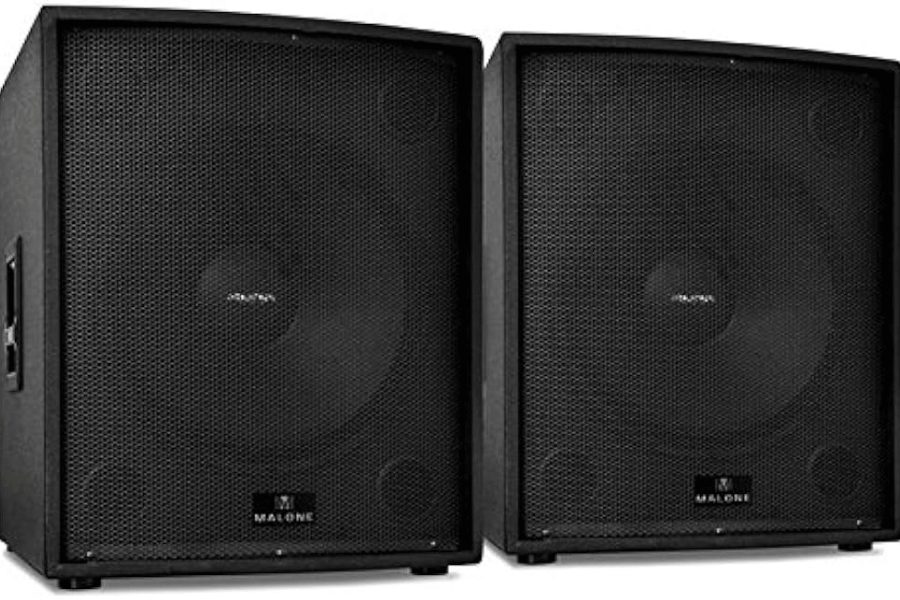If you’re a music enthusiast who values high-quality sound, subwoofers are a need. Any well-designed sound system would be incomplete without a subwoofer. One concern that many buyers have is finding the right types of subwoofers.
The following article will discuss subwoofers and the many varieties that are available. Audiosk examine powerful, cordless subwoofers as well as models tailored to certain musical styles. The deep, booming bass, however, is what truly sets it apart. Why don’t we find out together?

Understanding Subwoofers: A Beginner’s Guide
Listening to music or viewing a movie with subwoofer is essential for a full and enhanced sound experience. Its original function in the audio system was to generate very low and narrow frequencies, twenty hertz to two hundred hertz. This is the unique selling point of the subwoofer when it comes to low-volume, deep-bass sounds.
When compared to traditional speakers, subwoofers excel in reproducing low-frequency sounds. To recreate the thunderous, deep bass of electronic music and movie explosions, you need an outstanding subwoofer. It makes everything more interesting and rich.
There are several types of subwoofers, roughly 6 to 10 different types of what is categorized as a subwoofer.
Main types of subwoofers :
- Active subwoofer
- Passive subwoofer
Subwoofer variations:
- Ported subwoofer
- Front and Down Firing Subwoofers
- Horn Loaded Subwoofers
Choosing the best subwoofer is a difficult task. Which types of subwoofers do you think will work best for you? Find out everything you need to know about the different kinds of subwoofers by reading on.
Active And Passive Subwoofers: What Are The Key Differences?
What exactly does that mean and what is the difference between ‘active’ and ‘passive’ subwoofer?

Active Subwoofer
Active subwoofers are self-contained, including speakers, amplifiers and its own AC power source. For your powered subwoofer to serve you well, all you need is a line output (LFE out, pre-out, sub-out) from your receiver and AC power.
In sound systems for live performances as well as for home theatre setups, it is likely that the subwoofer will be active. The active subwoofer is equipped with volume and crossover controls and sometimes equalisers. This will allow you to adjust and optimize the sound easily and personally. Many active subwoofers have an automatic on/off feature, which enhances energy efficiency. Moreover, it is easy to install and set up, as all you need to do is connect it to the audio source and power it.
Customers who have purchased active subwoofers have spoken highly about how great they sound, how easy they are to operate, and how much better their home theater experiences are overall.
| Advantages | Disadvantages |
| Volume and Crossover Controls: Allow for easy adjustments to integrate with other speakers. | Cost: generally more expensive upfront due to integrated components. |
| Built-in Amplifier: Simplifies setup and eliminates the need for external amplification. | Heat Generation: The internal amplifier can generate heat, requiring good ventilation. |
| Compact Design: Ideal for space-saving in smaller rooms or setups. | Fixed Power Output: Power is limited to what the built-in amplifier can provide; there is no option for upgrading. |
| Ease of Connection: Direct connection to audio sources makes them user-friendly. |
Passive Subwoofers
A passive subwoofer consists of a single loudspeaker and an external amplifier; it does not have an amplifier within. Different designs, such as sealed, ported, and bandpass, produce different types of sound. Your subwoofer speaker can only handle bass effects if your amplifier can handle that much power. Your amplifier or receiver must be capable of sustaining bass effects without entirely depleting the battery if, for example, you need a subwoofer sound that is very low.

The speaker’s specifications and the room’s dimensions dictate the necessary power. The passive subwoofer receives audio signals via connections that link the external amplifier. It takes a little more effort to set up this subwoofer type properly.
| Advantages | Disadvantages |
| Customization: Allows for a personal audio setup with a wide choice of amplifiers. | Space Requirements: Requires more space for separate components in the audio setup. |
| Upgrade Flexibility: Components like the amplifier or subwoofer can be upgraded independently. | Additional Costs: Need for an external amplifier increases the initial investment. |
| Wide Power Range: Can handle a diverse range of power inputs, suitable for various applications. | Complex Setup: Requires more knowledge and effort to correctly match with an amplifier. |
| High-Quality Sound: Capable of delivering amazing bass with the right amplifier. |
Main Differences
A subwoofer is either active or passive based on whether or not it has an internal amplifier. In the end, it’s up to you to decide whether you want an active or passive subwoofer. The active subwoofer is more cost-effective and easier to install, while passive subwoofers offer more flexibility in choosing a compatible amplifier .
If you are looking for a simple and ready-to-use solution, the active subwoofer might be the ideal choice. On the other hand, if you are an audio enthusiast and want to maximise the quality and power of low frequencies, you should get a passive subwoofer.
Besides, installing a subwoofer to a factory stereo varies based on the subwoofer type. Active subwoofers, with built-in amplifiers, connect directly to the stereo’s audio output. Passive subwoofers require an external amplifier connected between the stereo and the subwoofer. Choosing the right type ensures easier installation and optimal sound compatibility with your factory stereo.
Various Additional Subwoofers
Beside the main group of subwoofers, there may be different variations on the naming terminology or outright different names.

Down Firing Subwoofers
This type of subwoofer employs a speaker that radiates downward, toward the floor. Down-firing subwoofers owe much of theiradvantages to gravity and physics. Therefore, they don’t shake or move around as much as subwoofers of other types do. With all of the weight centered, it holds the speaker in place better than other directional firing speakers.
One of the noticeable advantages is that the speaker is facing down on the floor and protected from dogs, kids, and other inadvertent damage. Unfortunately, there’s the downward-firing side effect of most of the bass energy being absorbed into the floor. This affects the raw power of the bass and, especially if it’s powerful enough, will cause the floor to shake for obvious reasons.
Ported subwoofer
A ported sub comes with an extra opening or hole, known as a port. The woofer and the port are responsible for moving the air out of the box to escape the enclosure. It can really boost the bass level of the subwoofer, allows you to get a bigger and louder sound from one box.
The ventilation port gives the ported subwoofer far more raw power to send its energy forward. If your setup is a little off, it can produce rattling and reduce the longevity of your cone.

Horn Loaded Subwoofers
Tapped Horn Subwoofers use the two sides of a high-powered, long-excursion driver in a ported cabinet. Designing the horn with care will allow you to transmit more electric energy into the air while using less power. In order to maximize storage capacity, the majority of horn-loading submarines have a folded form. Even though these subs are efficient, you have to reduce their frequency. Despite the variety of tools and complexity they include, they are frequently tiny and compact.
Futhermore, The free air subwoofer, a unique type among subwoofers, mounts directly to a board in a car, using the trunk space as an enclosure. This design saves space while delivering quality bass. Ideal for custom car audio setups where space is limited, free air subwoofers operate efficiently without a traditional enclosure, offering a flexible and efficient solution for deep bass in a vehicle’s audio system.
Final Thoughts
Do you have a favorite subwoofer design? As you can see, there are more subwoofers than what we listed here. It can all be pretty confusing at times, especially if it’s your first time building your own musical forte. If you need more advice and help with choosing the correct system, visit our blog at Audiosk.








